ABSTRACT
The purpose of this study is to examine the art literacy levels of fine arts education students. The study group consists of 111 music teacher candidate and 90 art teacher candidate, 201 students in total from Nigde Omer Halisdemir University, Fine Art Education Branch. The data of the work were collected by "Art Literacy Scale". The study was designed in a causal-comparative research model. In data analysis, "independent groups t-test technique" and "one-way variance analysis technique" were used. As a result of the study, it was determined that art literacy levels are similar in terms of department (music-picture), gender and class level change in education. In terms of the enjoyment of reading art books, it was seen that the level of using art literacy information of the individuals, the level of the need of defining information they have and the level of transferring their knowledge to performance were high, while the level of reaching art literacy information was similar. It was observed that students who liked or disliked to do research in the library had similar levels of using art literacy knowledge, transferring knowledge to performance, and attainment of art literacy information, while the level of the need of defining information they have was higher. In terms of reading frequency, those who read books daily as compared to those who read a book monthly were found to have higher levels of using their knowledge, knowledge transfer to performance and level of accessing their knowledge, while the levels of the need of defining information they have were similar.
Key words: Literacy, art literacy, music.
When the aims and objectives of current education and training curriculum are investigated, the concept of literacy seems to be emphasized directly or indirectly. Reading, writing, speaking and listening skills often come to mind as the most important elements of literacy. The changing conditions of the world we live in and therefore the innovations and changes in the individuals desired education are inevitable. Literacy is also a concept for an individual that needs to be possessed beyond basic skills, such as communication, reasoning, decision-making, which may also be reflected effectively in life. Literacy can be addressed by the ability of learners to use the knowledge and skills they have gained in their core lessons at the time and place they are needed, to analyze and reason about the problems in various situations, and to present the results in an effective way (Organization for Economic Co-operation and Development [OECD], 2003). This change in the concept of literacy is reflected in many areas and various types of literacy have emerged. These include computer literacy, cinema literacy, television literacy, visual literacy, information literacy, science literacy, environmental literacy, media literacy, mathematics literacy, screen literacy, game literacy, technology literacy, internet literacy, library literacy, visual art literacy, art literacy and so on. (Adıgüzel, 2005; Afacan and Åžentürk, 2016; Alpan-Bangir, 2008; Andrelchik, 2015; Apaydınlı and ÖzkeleÅŸ, 2013; Aslan and Deniz, 2011; Aşıcı, 2009; Aydın and AlakuÅŸ, 2012; Barnett, 2013; Barton, 2013; Csíkos and Dohany, 2016; Göçer and Tabak, 2013; Gündüz-Kalan, 2010; Heinich et al., 1989; Kesik, 2016; KurbanoÄŸlu and Akkoyunlu, 2002; Kurtaslan-Yıldırım, 2017; KurudayıoÄŸlu and Tüzel, 2010; Lozenski and Smith, 2012; Maniaci and Chandler-Olcott, 2010; Mercin and AlakuÅŸ, 2007; National Core Arts Standards, 2018; Nethery, 2013; Okan-Akın, Yücetoker, 2014; Önal, 2010; Özgen and Bindak, 2011; Roth, 2002; Shenfield, 2015; Tallim, 2010; Timur et al., 2013; Yalçınkaya and Eldemir, 2013; Yıldız et al., 2012; Yılmaz and Timur, 2014; Tüzel, 2010; Ünsal, 2015; Zoet-Moody, 2014). Art literacy is defined as the ability to contribute to and understand artistic issues that include visual arts (painting, drawing, pottery, etc.).
Artistic literacy is the knowledge and understanding necessary to truly participate in the arts (National Core Arts Standards, 2018). Art literacy is the development of interest and love for individuals in fine arts and artworks. And it is having the basic knowledge and skills to express personal feelings and thoughts using the universal language of art (http://sanatseverturkiye.blogspot.com.tr). Art teachers express art literacy in two interrelated perspectives. The first is literacy in a particular context while the other is used in a deeper disciplinary approach where students learn their skills and lead themselves in becoming artists (Barton, 2013). When each of these stages is examined, the individual must be able to understand how and where to find missing information on art, understand how to find the source of artistic information to be investigated, evaluate the obtained information by putting it in a conceptual framework and understand how and where to use the information work he/she evaluates (Okan-Akın and Yucetoker, 2016). The purpose of this study is to examine the art literacy levels of fine arts education students. For this purpose, the following sub-purposes are needed.
1. Is there any difference in terms of branches of education the students participate?
2. Is there any difference in terms of the sex of students?
3. Is there any difference in terms of readiness to read art books?
4. Is there any difference in terms of enjoying doing research in the library?
5. Is there any difference in terms of the different classes the students attend?
6. Is there any difference in terms of the reading frequency of the students?
Research model
This research is designed in a causal-comparative research model. Gay et al. (2011) point out that in the causal-comparative research model, the investigator tries to determine the cause of differences in behaviors or situations of groups or individuals. This study was conducted in a causal-comparative research model to examine whether there is any difference in art literacy in terms of the department of education, gender, grade level, liking of reading art books, liking to use the library and reading book frequency. Dependent variables of this research are using art literacy information, defining art literacy information needs, transferring art literacy knowledge to performance, and accessing art literacy information. The independent variables of the study are the branch that has been studied, gender, class level, readability of art books, liking to use library and book reading frequency.
The study group
The study group consists of 201 students studying at the fine arts department in Educational Faculty of NiÄŸde Ömer Halisdemir University, 129 of whom are female and 72 are male. Totally, the art and music departments have 300 students. 201 voluntary students out of 300 took part in data collection tools. Therefore, most students were reached.
Data collection tools
The "Art Literacy Scale" developed by Yucetoker (2014) was used as data collection tool in the research. The art literacy scale is rated in 5 types of likert as follows: "I am not having any difficulties at all", "I am not having difficulties", "I am undecided", "I am having some difficulties" and "I am having difficulties" The scale consists of 4 sub-factors which are "Using Art Literacy Information", "Defining Art Literacy Information Need", "Transferring Art Literacy Knowledge to Performance" and "Accessing Art Literacy Information". Internal Consistency Coefficients were calculated for reliability calculations of the scale. As a result of these calculations, reliability coefficients for sub-dimension of art literacy knowledge using, the definition of art literacy knowledge need, transferring of art literacy knowledge to performance and accessing art literacy knowledge are found as 0.75, 0.71, 0.78 and 0.74, respectively.
Data analysis
In this study, it was first checked whether there are missing values in the dataset. As a result of this review, there was no missing data found in the dataset. After that, it is examined whether there are any extreme values in the dataset. Z scores were calculated to examine extreme values, and no Z scores were found with a score greater than 3.29. For normality assumption, skewness and kurtosis values and histogram graph were examined. As a result of these examinations, it was seen that the data set has a normal distribution. In light of these, independent groups t-test and one- way variance analysis techniques were used for data analysis. Finally, the homogeneity of the variances was tested and it was found that the variances are homogeneous. The level of significance was determined as 0.05.
Independent groups t-test technique was used to examine whether art literacy levels changed in terms of variables such as the branch of education, gender, the likelihood of reading and liking to use the library, and findings are presented in the tables.
Findings related to art literacy in terms of the branch of education
There is no significant difference in the level of use of art literacy information in terms of the branch of education. (t(199)=-0.90, p> 0.05). In other words, the level of use of art and literacy by students of music and painting/art departments are similar (Table 1a). There is nosignificant difference in the need of definition on art literacy in terms of the branch of education. (t(199)=-0.71, p> 0.05). In other words, the need of art and music students for definition on art literacy is similar to each other (Table 1b). There is no significant difference in the level of transferring art literacy knowledge to performance in terms of the branch of education (t(199)=0.35, p> 0.05). In other words, the level of music and painting students' transferring art literacy knowledge to performance skill is similar (Table 1c). There is no significant difference in the level of access to art literacy information in terms of the branch of education (t(199)=-0.80, p> 0.05). In other words, music and painting department students have similar levels of access to art literacy information (Table 1d).
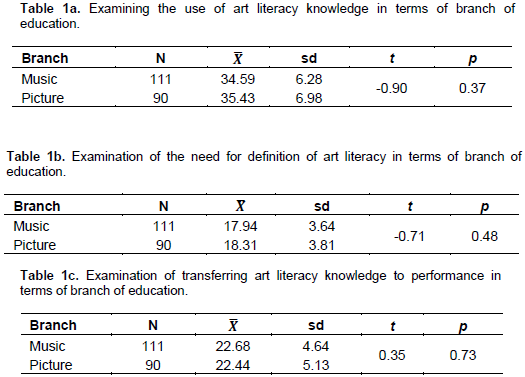

Findings on art literacy in terms of gender
There is no significant difference in the level of using art literacy information in terms of gender (t(199)= 1.63, p> 0.05). In other words, the levels of use of art literacy by male and female students are similar (Table 2a). There is no significant difference in the level of the need for definition on art literacy in terms of gender (t(199)= 0.65, p>0.05). In other words, the levels of definition on artistic literacy knowledge of male and female students are similar (Table 2b). There is no significant difference in the level of transferring art literacy knowledge to performance in terms of gender (t(199)= 1.48, p> 0.05). In other words, the levels of female and male students' transfer of art literacy knowledge to performance are similar (Table 2c). There is no significant difference in the level of access to art literacy information in terms of gender. (t(199)= 1.36, p> 0.05). In other words, the levels of access to art literacy by male and female students are similar (Table 2d).
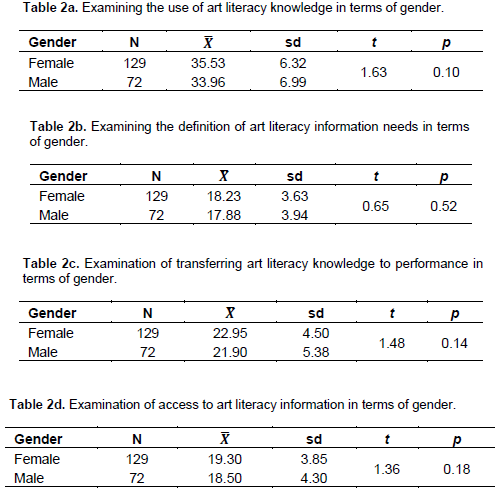
Findings related to art literacy in terms of enjoyment from reading
There is a meaningful difference in the level of using art literacy information in terms of enjoyment from reading (t(199)= 2.84, p< 0.05). In other words, individuals who enjoy reading art books are more likely to use art literacy knowledge (Table 3a). There is a meaningful difference in definition for art literacy knowledge in terms of enjoyment from reading (t(199)= 2.28, p< 0.05). In other words, individuals who enjoy reading art books are at a higher level of defining their artistic literacy needs (Table 3b). There is a meaningful difference in the level of transferring art literacy knowledge to performance in terms of enjoyment from reading (t(199)= 2.73, p< 0.05). In other words, individuals who enjoy reading art books have a higher level of transfer of art literacy knowledge to performance (Table 3c). There is no significant difference in the level of access to art literacy information in terms of enjoyment from reading(t(199)= 1.76, p> 0.05). In other words, the level of access to art literacy information by individuals who get enjoyment from reading is similar (Table 3d).
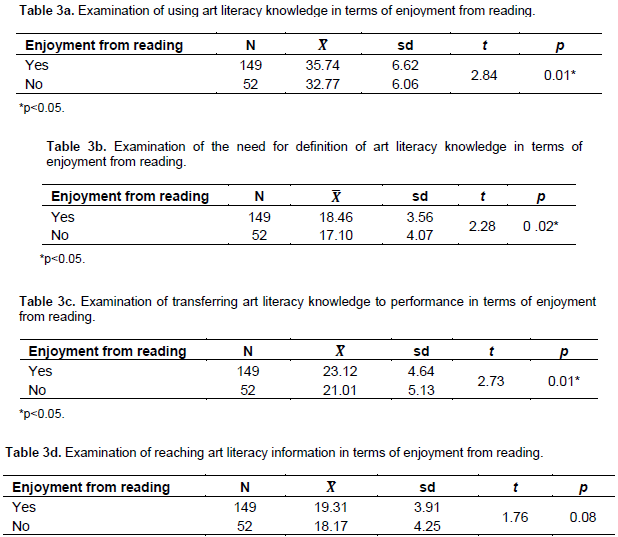
Findings on art literacy in terms of liking to do research in the library
There is no significant difference in the level of using literacy information in terms of library research. (t(199)= 1.83, p> 0.05). In other words, the level of use of art literacy information by students who love or dislike research in the library is similar (Table 4a). There is a meaningful difference in the level of the need of definition on art literacy knowledge in terms of liking to do research in the library (t(199)= 2.35, p< 0.05). In other words, individuals who love to do research in the library aremore likely to define art literacy needs (Table 4b). There is no significant difference in the level of transferring knowledge of art literacy to performance in terms of liking to do research in the library (t(199)= 0.87, p> 0.05). In other words, the levels at which students who love or dislike research in the library convey art literacy knowledge to performance are alike (Table 4c). There is no significant difference in the level of access to art literacy information in terms of liking to do research in the library (t(199)= 1.01, p>0.05). In other words, the level of access to art literacy information by students who love or dislike research in the library is the same (Table 4d).
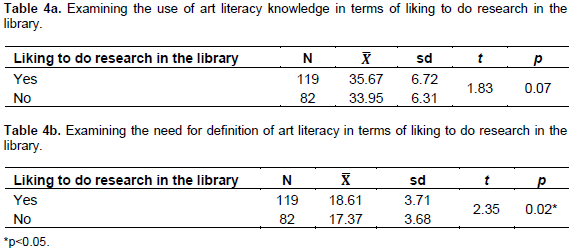
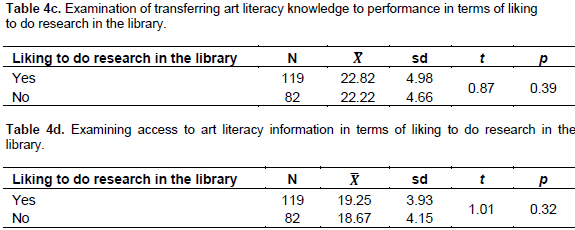
Findings related to art literacy in terms of class level variables
One way analysis of variance (One Way Anova) technique was used to investigate whether there is a meaningful difference in using art literacy knowledge in terms of class level, defining art literacy information need, conveying art literacy knowledge to performance, and accessing art literacy information. There was no significant difference in the level of using art literacy information in terms of class level (F(3.197)= 1.65, p> 0.05). It was concluded that the level of use of art literacy information by students in terms of the class levels they are studying is similar (Table 5). In terms of class level, there was no significant difference in the level of need of definition on the art literacy information (F(3, 197)= 0.35, p> 0.05). It was concluded that the levels of the need of definition on the art literacy knowledge are similar in terms of the class levels in which students learn. There was no significant difference in the level of transferring art literacy knowledge to performance in terms of class level (F(3, 197)= 2.26, p> 0.05). It was concluded that the level of students' transferring literacy to the performance in terms of the class levels they are studying is similar. There was no significant difference in the level of art literacy information in terms of class level (F(3, 197)= .52, p> 0.05). It is concluded that the levels of access to art literacy information are similar to each other in terms of class levels in which students learn (Table 6a). There is a significant difference in the level of using art literacy information in terms of reading frequency (F(4, 196)= 3.57, p< 0.05). The Tukey test was used to determine the source of the difference and it was found that daily readers of books had higher levels of using art literacy information than those who read one book in a month (Table 6b).
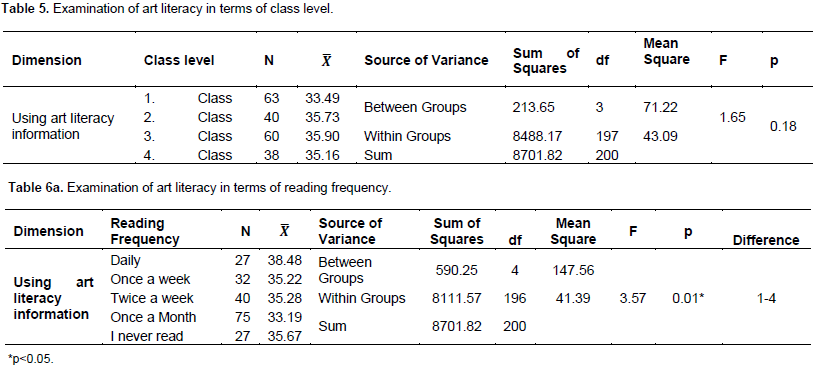
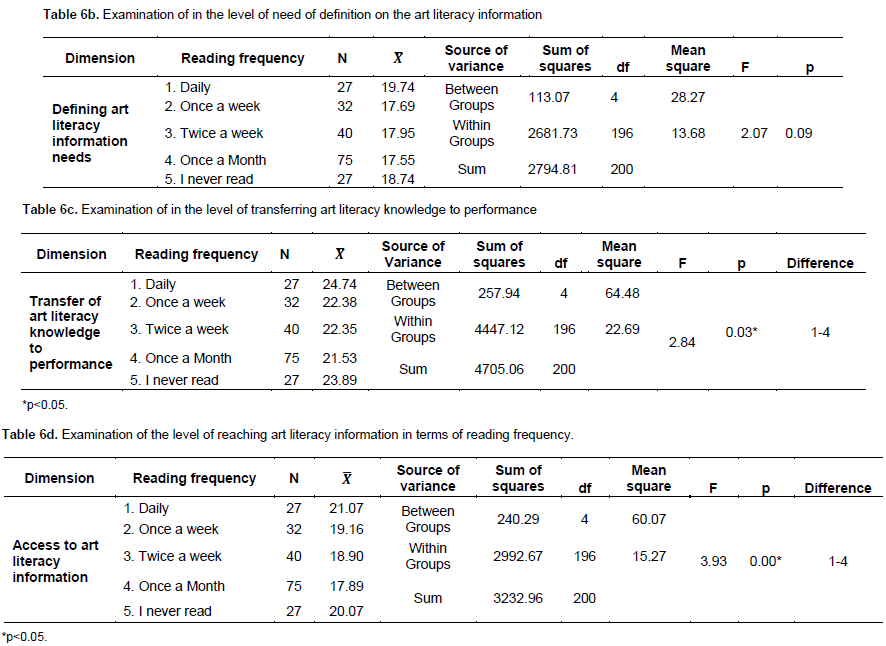
In terms of reading frequency, it was seen that there was no meaningful difference in the level of need of definition on the art literacy information (F(4, 196)= 2.07, p> 0.05). In terms of the frequency of reading books, the levels of students' need of definition on art literacy are similar. In terms of reading frequency, there was a significant difference in the level of transferring art literacy knowledge to performance.(F(4, 196)=2.84, p< 0.05) Tukey test was conducted to determine the source of the difference and it was found that those who read books daily had a higher level of skill of transferring art literacy knowledge to performance than those who read a book once a month (Table 6c). It was found that there is a meaningful difference in the level of reaching art literacy information in terms of reading frequency (F(4, 196)=2.84, p< 0.05). The Tukey test was conducted to determine the source of the difference and it was found that readers who read books daily had a higher level of access to art literacy information than those who read a book once a month (Table 6d).
According to the findings, there is no neaningful difference for levels of art literacy in terms of the coefficiency of the departments of the students. The levels of art literacy are found to be similar in terms of gender. Okan-Akin and Yucetoker (2016) found that the art literacy scale is similar to the gender variable in the application of the scale of art-work education in the field of education. But Ozgen and Bindak (2011) and Unsal (2015) found no difference in terms of gender in their research regarding high school students' self-efficacy beliefs for mathematics literacy. The results of these studies also coincide with the results of this work. Yildiz et al. (2012) found that there was a significant difference in some literacy subscales in terms of gender and school type variables in their studies called "examining the level of numerical literacy of secondary school students in Siirt according to gender, class and education variable". These outcomes do not coincide with the outcomes of our work. In this study, while the level of using art literacy information, the level of defining information needs, and the level of transferring knowledge to performance were found to be high in terms of enjoyment from reading, the levels of access to art literacy information were similar. Okan-Akin and Yucetoker (2016) found that art literacy levels of students who liked art books were higher than those of art literacy levels of students who did not like art books.
The result coincides with the results of the study. These results were expected. Because the students reading art books may enjoy art researches more than the ones who do not. While students who liked or disliked to do research in the library were found to be similar in their level of using art literacy knowledge, level of knowledge transfer to performance, and access of art literacy information, the levels of defining the need for knowledge were higher. Okan-Akin and Yucetoker (2016) found that students who liked to do library research had higher art literacy levels than students who do not like doing library research. The result shows that library research is important for art students. In this study, the levels of art litearcy were found similar in terms of grade level coefficient. In a similar study, Ozgen and Bindak (2011) and Unsal (2015) found no difference in terms of grade level in their research regarding high school students' self-efficacy beliefs for mathematics literacy. The results of these studies also coincide with the results of this work. However, Yucetoker (2015) found that literacy levels rose as the class level increased in his research titled as "evaluation of art literacy levels of fine arts education students". These results of these studies do not coincide with the results of this work. According to another result of this study, daily book readers as compared to those who read a book once a month had same levels of using their knowledge, transferring their knowledge to performance and accessing their knowledge which shows how important and useful reading books daily is.
Taking the results of the study into consideration, throughout art education, every student should be improved in line with their own unique personality. He or she should be guided in the direction of their own personality and tendencies and should express themselves freely. Also, students should be encouraged to read art books and do research in libraries. Children and young people need to be directed at artistic activities that will help them improve their personality. Art education is seen as a theory course with emphasis on art history and education in the course curriculum. It is believed that having these lessons allows students to do more library research. However, when it comes to music education curriculum, it is seen that the number of these courses is limited. For this reason, music education students cannot achieve efficiency in this area other than through their own research. According to these results, restructuring of the curriculum of music education is thought to be important in terms of increasing literacy levels of students in the curriculum of courses such as art literacy. It is very important for students to be directed to the libraries as library research for the students of the fine arts department is very important. It is also thought that art teachers' suggestions for scientific articles, texts or art books that can be useful for students to develop themselves will be effective in this field and thus contribute to the field.
The author has not declared any conflict of interests.
REFERENCES
|
Adıgüzel A (2005). Avrupa birliÄŸine uyum sürecinde öÄŸretmen niteliklerinde yeni birboyut: bilgi okur-yazarlığı. Milli EÄŸitim Dergisi, 167:53-70.
View
|
|
|
|
Afacan Åž, Åžentürk N (2016). Okul öncesi ve sınıf eÄŸitimi anabilim dallarına yönelik. Müzik okuryazarlığı ölçeÄŸinin geliÅŸtirilmesi. Int. J. Eurasia Soc. Sci. 7(25):228-247.
|
|
|
|
Alpan-Bangir G (2008). Görsel okuryazarlık ve öÄŸretim teknolojisi. Yüzüncü Yıl Üniversitesi EÄŸitim Fakültesi Dergisi, 5(2):74-102.
|
|
|
|
Aslan L, ve Deniz J (2011). "Ä°lköÄŸretim mezunu öÄŸrencilerin müzik okuryazarlık düzeyleri". Marmara Üniversitesi Atatürk EÄŸitim Fakültesi EÄŸitim Bilimleri Dergisi, Sayı: 34:25-34.
|
|
|
|
Andrelchik H (2015). Reconsidering literacy in the art classroom, Art Education. 68(1):7-11.
|
|
|
|
Apaydınlı K, ÖzkeleÅŸ S (2013). Türkiye'de cumhuriyet döneminden günümüze sanat eÄŸitiminde müzik okuryazarlığı. 4. Uluslararası
|
|
|
|
Aşıcı M (2009). Kişisel ve sosyal bir değer olarak okuryazarlık, Değerler EğitimiDergisi, 7(17):9-26.
|
|
|
|
Aydın S, AlakuÅŸ AO (2012). Görsel sanatlar okuryazarlığı. 21.Ulusal EÄŸitimBilimleri Kongresinde sunuldu, Ä°stanbul.
|
|
|
|
Barnett M (2013). The arts as a bridge to literacy. Principal J. pp. 20-22. Web:
View
|
|
|
|
Barton G (2013). The Arts and Literacy: What Does it Mean to be Arts Literate? Int. J. Educ. Arts, 14(18):22.
|
|
|
|
Csíkos C, Dohány G (2016). Connections Between Music Literacy and Music-RelatedBackground Variables: An Empirical Investigation. Visions of Research in Music Education, P 28.
|
|
|
|
Gay LR, Mills GE, Airasian P (2011). Educational research: Competencies for analysis and applications (10th ed.). New Jersey: Pearson.
|
|
|
|
Göçer A, Tabak G (2013). ÖÄŸretmen adaylarının 'görsel okuryazarlık' ile ilgilialgıları. Adıyaman Üniversitesi Sosyal Bilimler Enstitüsü Dergisi, pp. 517-541.
Crossref
|
|
|
|
Gündüz-Kalan Ö (2010). Medya okuryazarlığı ve okul öncesi çocuk: ebeveynlerin medyaokuryazarlığı bilinci üzerine bir araÅŸtırma. Ä°stanbul Üniversitesi Ä°letiÅŸim Fakültesi Hakemli Dergisi, 1(39):59-73.
|
|
|
|
Heinich R, Molenda M, Russel JD (1989). Instructional media and new technologies of instruction.(Third Edition). Macmillan Publishing Company.
|
|
|
|
Kesik C (2016). Ä°lkokul üçüncü sınıf öÄŸrencilerinin fen okuryazarlık düzeyleri. EÄŸitimde Kuram ve Uygulama, 12(6):1139-1159.
|
|
|
|
KurbanoÄŸlu S, ve Akkoyunlu B (2002). ÖÄŸretmen adaylarına uygulanan bilgi okuryazarlığıprogramının etkililiÄŸi ve bilgi okuryazarlığı becerileri ile bilgisayar öz-yeterlik algısıarasındaki iliÅŸki. Hacettepe Üniversitesi EÄŸitim Fakültesi Dergisi, 22:98-105.
|
|
|
|
Kurtaslan-Yıldırım H (2017). Evaluation of art literacy levels of students who study in fine arts high school in terms of variables.EKEV Akademi Dergisi, 70:39-56.
|
|
|
|
KurudayıoÄŸlu M, Tüzel S (2010). 21. Yüzyıl okuryazarlık türleri, deÄŸiÅŸen metinalgısı ve Türkçe eÄŸitimi. Türklük Bilimi AraÅŸtırmaları, 28:283-298.
|
|
|
|
Lozenski B, Smith C (2012). Pen 2 paper 2 power: lessons from an arts-based literacyprogram serving somali immigrant youth. Equity Excellence Educ. 45(4):596-611.
Crossref
|
|
|
|
Maniaci K, Chandler-Olcott K (2010). Still building that idea: preservice art educators'perspectives on integrating literacy a cross the curriculum. Int. J. Educ. Arts 11(4):1-41. Web:
|
|
|
|
Mercin L, AlakuÅŸ AO (2007). Birey ve toplum için sanat eÄŸitiminin gerekliliÄŸi, DicleÜniversitesi Ziya Gökalp EÄŸitim Fakültesi Dergisi, 9:14-20.
|
|
|
|
National Core Arts Standards (2018). National core arts standards: a conceptual framework for arts learning.
View
|
|
|
|
Nethery C (2013). Literacy+art=high-level thinking, Art and Activities, 24-33.
View
|
|
|
|
Okan-Akın N, Yücetoker Ä° (2016). Sanat okuryazarlığı ölçeÄŸinin resim-iÅŸ eÄŸitimi anabilimdalında uygulanması. VIII. Uluslararası EÄŸitim AraÅŸtırmaları Kongresi. Çanakkale. 1296-1301.
|
|
|
|
Organization for Economic Co-operation and Development [OECD] (2003). The PISA 2003 assessment framework – mathematics, reading, science and problem solving knowledge and skills. Paris Author.
|
|
|
|
Önal Ä° (2010). Tarihsel deÄŸiÅŸim sürecinde yaÅŸam boyu öÄŸrenme ve okur-yazarlık:Türkiye deneyimi. Bilgi Dünyası, 11(1):101-121.
View
|
|
|
|
Özgen K, Bindak R (2011). Lise öÄŸrencilerinin matematik okuryazarlığınayönelik öz-yeterlik inançlarının belirlenmesi. Kuram ve Uygulamada EÄŸitimBilimleri, 11(2):073-1089.
|
|
|
|
Roth CE (2002). A Questioning framework for shaping environmental literacy (US, Earthlore Associates & The Center for Environmental Education of Antioch New England Institute).
View
|
|
|
|
Shenfield R (2015). Literacy in the arts, literacy learning: The Middle Years, 23(1):47-53.
View
|
|
|
|
Tallim J (2010). What is Media Literacy? Media Awareness Network.
|
|
|
|
Timur B, Yılmaz Åž, Timur S (2013). Çevre okuryazarlığı ile ilgili 1992-2012 yıllarıarasında yayımlanan çalışmalarda genel yönelimlerin belirlenmesi. Mehmet Akif Ersoy Üniversitesi EÄŸitim Bilimleri Enstitüsü Dergisi 3(5):22-41.
|
|
|
|
Tüzel S (2010). Görsel okuryazarlık, Türklük Bilimi AraÅŸtırmaları 27:691-705.
|
|
|
|
Ünsal H (2015). Meslek lisesi ve teknik lise öÄŸrencilerinin bilgi okur-yazarlık düzeyleri. Kuramsal EÄŸitim Bilim Dergisi, 8(3):421-436.
View
|
|
|
|
Yalçınkaya B, Eldemir A (2013). Müzik öÄŸretmeni adaylarının alana yönelik bilgisayar okuryazarlığı düzeylerinin belirlenmesi, Turkısh Studies, - International Periodical For The Languages, Literature and History of Turkish or Turkich, 8(8):2185-2195.
|
|
|
|
Yıldız Ç, KahyaoÄŸlu M, Kaya MF (2012). Siirt ilindeki ortaöÄŸretim öÄŸrencilerinin sayısal okuryazarlık düzeylerinin cinsiyet, sınıf ve öÄŸrenim gördüÄŸü lise türüne göre farklılaÅŸmasının incelenmesi, UÅŸak Üniversitesi Sosyal Bilimler Dergisi, 5(3):82-96.
|
|
|
|
Yücetoker Ä° (2014). Sanat okuryazarlığı ölçeÄŸinin hazırlanması ve geliÅŸtirilmesi, Sanat EÄŸitimi Dergisi, 2(1):112-126.
|
|
|
|
Zoet-Moody E (2014). Integrating art education and literacy education: a curriculum for the secondary level. Master theses, Western Michigan University, USA.
View
|